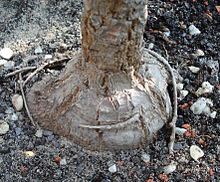Cussonia
| Cussonia | ||||||||||||
|---|---|---|---|---|---|---|---|---|---|---|---|---|

Leaves of Cussonia spicata |
||||||||||||
| Systematics | ||||||||||||
|
||||||||||||
| Scientific name | ||||||||||||
| Cussonia | ||||||||||||
| Thunb. |
The plant genus Cussonia belongs to the Araliaceae family. The 20 to 25 species are widespread from tropical to southern Africa and the Mascarene Islands .
description

Vegetative characteristics
The Cussonia species are evergreen or deciduous in the dry season, mostly sparsely branched trees with heights of 5 to 15 meters or bushes . The above-ground parts of the plant are, depending on the type and age, bald to more or less hairy. Some species form a thickening ( lignotuber ) at the base of the trunk .
The leaves, which are often in (“umbrella-like”) “tufts” at the ends of the twigs or trunks, are divided into a petiole and a leaf blade. The leaf stalks are remarkably long. The leaf blade, which is often silver-green, is split in the shape of a hand and has serrated leaf edges. (The English common name "Cabbage Tree " is derived from these "tufts" .) The stipules are often very noticeable.
Inflorescence and flowers
Several piston-like inflorescences stand together at the branch ends. The bracts are only small or rudimentary .
The hermaphroditic, rarely four or mostly five-fold flowers have a diameter of 4 to 8 millimeters and a double flower envelope . The rarely four, mostly five short sepals are at least almost completely fused into a cup. The rarely four, usually five petals are yellowish-green. There is only one circle with rarely four, usually five stamens . The disc is flat or fused with the stylus to form a conical stylopodium . Usually two carpels are at a two-chambered ovary grown. There are usually two styluses.
Infructescence, fruits and seeds
The often black-violet drupes , which sit close together in the fruit cluster when ripe, are almost spherical, urn-shaped, obovate or inverted-conical to wedge-shaped and sometimes fleshy. The seeds are ovate to slightly flattened.
use
Different parts of plants are used as natural medicine. The wood has a corky structure and was used to brake carriages and wagons.

Systematics
The genus Cussonia was established in 1780 by Carl Peter Thunberg in Nova Acta Regiae Societatis Scientiarum Upsaliensis , Volume 3, p. 210, plates 12 & 13. A synonym for Cussonia Thunb. is Sphaerodendron Seem. The generic name Cussonia honors the French doctor and botanist Pierre Cusson (1727–1783).
There are around 20 to 25 species of Cussonia :
- Cussonia angolensis (Seem.) Here : It is common in Zaire , Angola and northwestern Namibia .
- Cussonia arborea Hochst. ex A.Rich. : It is widespread in tropical Africa.
- Cussonia arenicola Strey : It occurs in Mozambique and in the South African province of KwaZulu-Natal .
- Cussonia bancoensis Aubrév. & Pellegr. : It is distributed from tropical West Africa to the Republic of the Congo .
- Cussonia brieyi De Wild. : It iswidespreadfrom Zaire to northern Angola .
- Cussonia corbisieri De Wild. : It is distributed from southern Zaire to Zambia .
- Cussonia gamtoosensis Strey : This rare species thrives on dry and rocky slopes only in the Gamtoos River Valley in the South African province of Eastern Cape .
- Cussonia holstii Harms ex Engl .: The distribution area extends from Yemen and Ethiopia to Tanzania .
- Cussonia jatrophoides Hutch. & EABruce : The home is Tanzania.
- Cussonia natalensis Sond. ex WHHarver : It is common in Zimbabwe , Swaziland and in the South African provinces of KwaZulu-Natal , Limpopo and Mpumalanga .
- Cussonia nicholsonii Strey : It occurs only in the South African provinces of Eastern Cape and KwaZulu-Natal.
- Cussonia ostinii Chiov. : The home is Ethiopia.
-
Cussonia paniculata Eckl. & Zeyh. : There are two subspecies:
- Cussonia paniculata Eckl. & Zeyh. subsp. paniculata : It occurs in the South African provinces of KwaZulu-Natal, North , East and West Cape .
- Cussonia paniculata subsp. sinuata (Reyneke & Kok) De Winter : It is distributed from Botswana , Lesotho and Swaziland to the South African provinces of Free State , Gauteng , KwaZulu-Natal, Limpopo, Mpumalanga and North West .
- Cussonia sessilis Lebrun : The home is Zaire.
- Cussonia sphaerocephala Strey : It occurs in Swaziland and in the South African provinces of Eastern Cape and KwaZulu-Natal.
- Cussonia spicata Thunb. : The distribution area extends from Sudan to the South African provinces of Gauteng, KwaZulu-Natal, Limpopo, Mpumalanga, North West, Eastern Cape, Western Cape and the Comoros.
- Cussonia thyrsiflora Thunb. : It occurs only in the northern South African provinces of the Eastern and Western Cape.
- Cussonia transvaalensis Reyneke : It occurs only in the northern South African provinces of Gauteng, Limpopo, Mpumalanga and North West.
- Cussonia zimmermannii Harms : The distribution area extends from Kenya to Mozambique.
- Cussonia zuluensis Strey : It occurs from Mozambique to the South African provinces of KwaZulu-Natal and Mpumalanga.
swell
- JFM Cannon: Araliaceae in the Flora Zambesiaca , Volume 4, 1978: Cussonia - Online.
- Entry in the Flora of Zimbabwe . (Section description)
Individual evidence
- ^ A b Cussonia in the Germplasm Resources Information Network (GRIN), USDA , ARS , National Genetic Resources Program. National Germplasm Resources Laboratory, Beltsville, Maryland.
- ↑ Lotte Burkhardt: Directory of eponymous plant names. Extended Edition. Botanic Garden and Botanical Museum Berlin, Free University Berlin Berlin 2018. online.
- ↑ a b c d e f g h i j k l m n o Rafaël Govaerts (Ed.): Cussonia. In: World Checklist of Selected Plant Families (WCSP) - The Board of Trustees of the Royal Botanic Gardens, Kew . Retrieved April 29, 2018.
- ↑ a b c d e f g h i j k Species list for Cussonia in the Red List of South African Plants
- ↑ Cussonia paniculata at PlantzAfrica .


